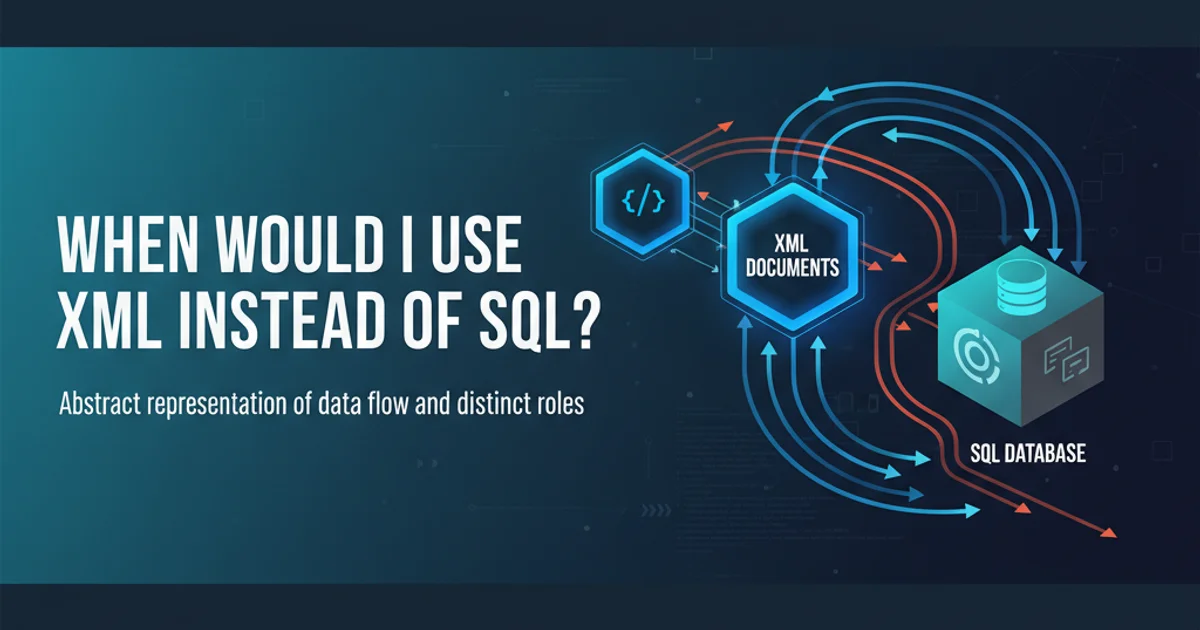When would I use XML instead of SQL?
XML vs. SQL: When to Choose Which for Data Storage and Exchange

Explore the fundamental differences between XML and SQL, and learn when to leverage each technology for optimal data management, exchange, and application development.
In the realm of data management and information exchange, SQL (Structured Query Language) and XML (Extensible Markup Language) are two foundational technologies. While both deal with data, they serve different primary purposes and excel in distinct scenarios. Understanding their core characteristics and use cases is crucial for making informed architectural decisions. This article will delve into when to choose XML over SQL, highlighting their strengths and weaknesses.
Understanding SQL: Relational Data and Structured Queries
SQL is the standard language for managing and querying relational databases. It's designed for highly structured data that fits well into tables with predefined schemas. SQL databases enforce data integrity, support complex queries, and are optimized for transactional operations (ACID properties). They are the backbone of most business applications requiring persistent, consistent, and queryable data storage.
CREATE TABLE Products (
ProductID INT PRIMARY KEY,
ProductName VARCHAR(255) NOT NULL,
Category VARCHAR(100),
Price DECIMAL(10, 2)
);
INSERT INTO Products (ProductID, ProductName, Category, Price)
VALUES (1, 'Laptop', 'Electronics', 1200.00);
SELECT ProductName, Price FROM Products WHERE Category = 'Electronics';
Example SQL for table creation, data insertion, and querying.
Understanding XML: Self-Describing Hierarchical Data
XML is a markup language that defines a set of rules for encoding documents in a format that is both human-readable and machine-readable. Unlike SQL, XML is not a database itself but a format for structuring and transporting data. It's inherently hierarchical and self-describing, meaning the data comes with its own schema definition. This makes XML highly flexible and ideal for data exchange between disparate systems, configuration files, and documents with complex, nested structures.
<?xml version="1.0" encoding="UTF-8"?>
<products>
<product id="1">
<name>Laptop</name>
<category>Electronics</category>
<price currency="USD">1200.00</price>
<features>
<feature>16GB RAM</feature>
<feature>512GB SSD</feature>
</features>
</product>
<product id="2">
<name>Smartphone</name>
<category>Electronics</category>
<price currency="USD">800.00</price>
</product>
</products>
Example XML structure for product data, showing hierarchical and self-describing nature.
When to Choose XML Over SQL
The decision to use XML instead of, or in conjunction with, SQL often boils down to the primary purpose of the data. Here are key scenarios where XML is the preferred choice:
flowchart TD
A[Start]
A --> B{Data Exchange between Systems?}
B -->|Yes| C[XML is Excellent]
B -->|No| D{Configuration Files or Document Storage?}
D -->|Yes| E[XML is Good]
D -->|No| F{Highly Unstructured or Semi-structured Data?}
F -->|Yes| G[XML is Suitable]
F -->|No| H{Complex, Nested Data Structures?}
H -->|Yes| I[XML is Ideal]
H -->|No| J[Consider SQL for Relational Data]
C --> K[End]
E --> K
G --> K
I --> K
J --> KDecision flow for choosing XML based on data characteristics and use cases.
- Data Exchange Between Disparate Systems: XML's self-describing nature and platform independence make it an excellent format for exchanging data between systems that may use different underlying databases or programming languages. APIs (like SOAP) frequently use XML for message payloads.
- Configuration Files: Many applications use XML for configuration settings due to its human-readability and hierarchical structure, which naturally maps to application settings (e.g.,
web.configin .NET,pom.xmlin Maven). - Document-Oriented Data: For data that is more like a document than a rigid table (e.g., articles, books, reports with varying sections and metadata), XML provides a flexible structure. While some databases now support XML data types, XML itself is the format.
- Semi-structured or Unstructured Data: When data doesn't fit neatly into a relational schema, or its structure changes frequently, XML offers greater flexibility. It can represent optional elements, repeating elements, and nested hierarchies more naturally than flat tables.
- Small to Medium Data Volumes for Portability: For smaller datasets that need to be easily transported, viewed, or edited outside of a database context, XML files are a convenient choice.
- Data with Complex Hierarchical Relationships: If your data inherently has deep, nested relationships that are difficult to model efficiently in a flat relational table, XML's tree-like structure is often more intuitive.